|
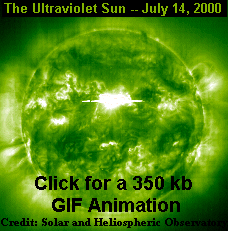 July 14, 2000 -- This morning NOAA satellites
and the orbiting Solar and Heliospheric Observatory (SOHO) recorded one of the most
powerful solar flares of the current solar cycle. Space weather
forecasters had been predicting for days that an intense flare might erupt
from the large sunspot group 9077, and today one did. July 14, 2000 -- This morning NOAA satellites
and the orbiting Solar and Heliospheric Observatory (SOHO) recorded one of the most
powerful solar flares of the current solar cycle. Space weather
forecasters had been predicting for days that an intense flare might erupt
from the large sunspot group 9077, and today one did.
"Energetic
protons from the flare arrived at Earth about 15 minutes after the
eruption," says Gary Heckman, a space weather forecaster at the NOAA Space
Environment Center. "This triggered a category S3 radiation
storm."
Right:
This SOHO animation of the July 14th X-class
solar flare was recorded by the spacecraft's Extreme-ultraviolet Imaging
Telescope at 195 angstroms. A 350
kb GIF movie nicely shows the flare, followed by a torrent of
energetic particles that arrived about 15 minutes later, creating snow on
the images as the particles bombarded the camera's electronic
detectors.
According to NOAA space weather prediction
scales, an S3 storm can cause the following effects on satellites:
single-event upsets, noise in imaging systems, permanent damage to exposed
components/detectors, and decrease of solar panel currents. It can also
expose air travelers at high latitudes to low levels of radiation, the
equivalent of a brief chest x-ray.
The
wave of solar particles - known as a solar proton event - is already four
times more intense than any other event detected since the launches of
SOHO in 1995 and ACE in 1997. At mid-afternoon (UT) on July 14th, the
storm of particles from the Sun was still intensifying.
"The energetic particles from this flare
arrived very quickly," continued Heckman. "Protons have been observed in
the past to arrive between 15 minutes and several hours after a flare.
This event was definitely one of the fastest, but we don't yet have all
the numbers to say exactly how it ranks in this category."
| "Given the
information I have now, if I was advising my own daughter I would
tell her it's safe to fly. In fact, if she were going to come visit
me today (she lives in Florida and I'm in Oklahoma), I would tell
her to take a plane rather than drive because even during this solar
radiation event flying would be safer." -- Dr. Wallace Friedberg
of the Federal Aviation Administration's Civil Aeromedical Institute
in Oklahoma City, July 14,
2000. |
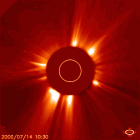 Soon after the solar flare, which occurred at 1024
UT (6:24 a.m EDT), coronagraphs on board the ESA/NASA Solar and
Heliospheric Observatory recorded a "full-halo" coronal mass ejection
(CME). CMEs are gigantic bubbles of electrified gas carrying away as much
as 10 billion tons of solar material. This one appears to be heading
toward our planet at 1300 to 1800 km/s. Soon after the solar flare, which occurred at 1024
UT (6:24 a.m EDT), coronagraphs on board the ESA/NASA Solar and
Heliospheric Observatory recorded a "full-halo" coronal mass ejection
(CME). CMEs are gigantic bubbles of electrified gas carrying away as much
as 10 billion tons of solar material. This one appears to be heading
toward our planet at 1300 to 1800 km/s.
Right: A full halo coronal
mass ejection recorded on July 14, 2000, by SOHO's C2 coronagraph. "Halo
events" are CMEs aimed toward the Earth. As they loom larger and larger
they appear to envelop the Sun, forming a halo around our star. The many
speckles in the latter half of this animation are energetic particles from
a related solar flare bombarding SOHO's electronic detectors. "The SOHO
instruments look like someone aimed a Gatling gun at them," commented
NOAA's Gary Heckman. Click
on the image for a larger animation.
There's
no cause for alarm. When a CME hits the magnetosphere -- the region around
Earth controlled by our planet's magnetic field -- most of the incoming
material is deflected away. If the shock wave is very strong, as this one
might be, it can compress the magnetosphere and unleash a geomagnetic
storm. In extreme cases, such storms can induce electric currents in the
Earth that interfere with electric power transmission equipment. Satellite
failures are possible, too. Geomagnetic storms can also trigger beautiful
aurorae. These "Northern Lights" are usually seen at high latitudes, but
they have been spotted farther south than Florida during intense
disturbances. The last time this happened was April 6,
2000.
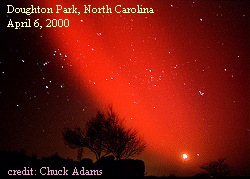 "At this time, I'm making plans to look for the aurora
Saturday night," says Heckman, who lives in Colorado. "At this time, I'm making plans to look for the aurora
Saturday night," says Heckman, who lives in Colorado.
Whether or
not an auroral display is triggered by the blast depends on the
orientation of the magnetic field within the CME's approaching shock wave.
Magnetic fields with a southward directed component can create a weak
point in Earth's magnetic defenses and make auroras more
likely.
Above: This rare red-colored aurora over North Carolina was
photographed by Chuck Adams on April 6, 2000. The bright object near the
horizon is the Moon. Also visible in the background are the Pleiades,
Taurus, and Orion. The photographer used a Nikon FM2 camera equipped with
a 28mm f/2 lens. The exposure time was one minute on Kodak Elite 100 slide
film. (Copyright 2000, Chuck Adams, all rights reserved.)
The Moon will be full this weekend when the solar disturbance is
expected to hit. Bright moonlight will outshine faint Northern and
Southern Lights, but vivid aurora could still be visible in spite of the
lunar interference. Observers across the Pacific might be treated to the
very rare sight of shimmering colorful aurora during the
total lunar eclipse of July 16th!
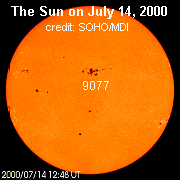 Sunspot group 9077, which triggered today's solar
flare and coronal mass ejection, exhibits a complex magnetic field that
harbors energy for powerful eruptions. Sunspot group 9077, which triggered today's solar
flare and coronal mass ejection, exhibits a complex magnetic field that
harbors energy for powerful eruptions.
Left: This July 14th image of
the Sun was captured by the Michelson
Doppler Imager on board the Solar and Heliospheric Observatory. The
large sunspot group, numbered 9077, is near the center of the Sun's
visible disk.
"Solar flares and CMEs occur whenever there's
a rapid, large-scale change in the Sun's magnetic field," explains David
Hathaway, a solar physicist at the NASA Marshall Space Flight Center. "The
solar active region that produced the eruptions [on July 14] had a
complicated magnetic configuration. Oppositely-directed magnetic fields
were seen right next to each other."
Active region 9077 is very
near the center of the Sun's visible disk. Solar rotation will carry the
sunspot group toward the Sun's western limb by late next week. For the
next few days, however, any additional eruptions are likely to be
Earth-directed. The fireworks may not be over yet!
Stay tuned
to Science@NASA for news and
updates about the coming geomagnetic disturbance.
Below: Solar Flares
are classified by their x-ray flux in the 1.0 - 8.0 Angstrom band as
measured by the NOAA GOES-8 satellite. On July 14, 2000, a solar flare
from active region 9077 registered as a powerful X5-class eruption.
Another X-class flare from 9077 was recorded on July 12, 2000.
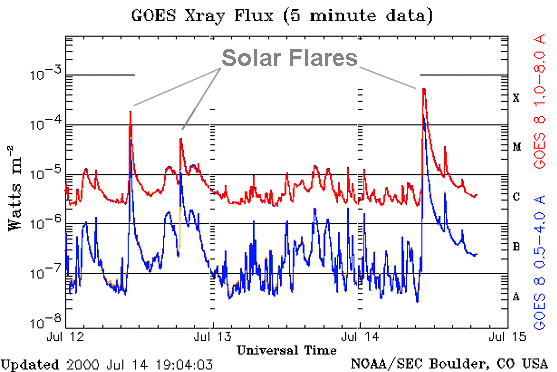
SOHO is a cooperative project between the European Space Agency
(ESA) and NASA. The spacecraft was built in Europe for ESA and equipped
with instruments by teams of scientists in Europe and the
USA. |





 "At this time, I'm making plans to look for the aurora
Saturday night," says Heckman, who lives in Colorado.
"At this time, I'm making plans to look for the aurora
Saturday night," says Heckman, who lives in Colorado. 

 Headlines
Headlines